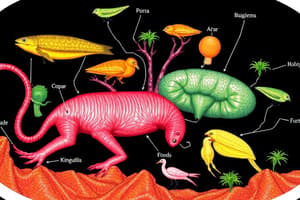Podcast
Questions and Answers
Which level of classification comes right after kingdom in the taxonomy system?
Which level of classification comes right after kingdom in the taxonomy system?
- Genus
- Order
- Phylum (correct)
- Family
How many kingdoms are currently recognized in the biological classification scheme?
How many kingdoms are currently recognized in the biological classification scheme?
- Seven
- Six
- Four
- Five (correct)
Which kingdom consists entirely of prokaryotes like bacteria and archaea?
Which kingdom consists entirely of prokaryotes like bacteria and archaea?
- Animalia
- Fungi
- Plantae
- Monera (correct)
What is the correct order of the taxonomic ranks from largest to smallest?
What is the correct order of the taxonomic ranks from largest to smallest?
Which of the following is NOT one of the five recognized kingdoms in biological classification?
Which of the following is NOT one of the five recognized kingdoms in biological classification?
What is the biological classification level that comes right after phylum?
What is the biological classification level that comes right after phylum?
Which classification level in biology is used to indicate differences in structural complexity, development patterns, or body plan?
Which classification level in biology is used to indicate differences in structural complexity, development patterns, or body plan?
What is the classification level that specifies particular details of structure and lifestyle, narrowly defining closely related kinds of species within a superorder?
What is the classification level that specifies particular details of structure and lifestyle, narrowly defining closely related kinds of species within a superorder?
In biological classification, which level brings together even closer relatives and contains a mix of genera and species?
In biological classification, which level brings together even closer relatives and contains a mix of genera and species?
What classification level represents a group of individuals able to interbreed with each other?
What classification level represents a group of individuals able to interbreed with each other?
Flashcards are hidden until you start studying
Study Notes
Biological Classification: Taxonomy, Kingdoms, Phylum, Class, Order
Biological classification is a systematic framework used to identify, name, and organize living organisms into groups based on their evolutionary relationships. The most prevalent method of classification is taxonomy, which uses a series of increasingly specific categories, starting from the largest to the smallest. Here we will explore the key concepts of taxonomy and some of the major groups: kingdoms, phylum, class, order, family, genus, and species.
Taxonomy
Taxonomy is the science of classifying living things based on shared physical traits and evolutionary history. Within taxonomy, there are several levels of classification, with the eight primary ones being kingdom, phylum or division, class, order, family, genus, and species. At the topmost level is the kingdom, then phylum, class, order, family, genus, and species at the bottom.
Kingdoms
Kingdoms represent one of the highest taxonomic ranks in the biologic classification scheme. Currently, there are five kingdoms recognized: Animalia, Plantae, Fungi, Protista, and Monera. Each kingdom contains numerous species sharing common traits. The Monera kingdom, for example, consists entirely of prokaryotes like bacteria and archaea.
Phylum
After kingdom comes phylum, which is a broader category containing three to ten class levels. While the exact number varies depending on the organism type, it serves to distinguish major lineages, such as Porifera (sponges) falling within the Animalia kingdom.
Class
Below phylum is class—more specific than the kingdom, yet less specific than phylum. An example of a class is Mammalia, encompassing everything from whales to elephants. Class is often used to indicate differences in structural complexity, development patterns, or body plan.
Order
Order is a more refined classification, designated after class. Like class, order specifies particular details of structure and lifestyle, narrowly defining closely related kinds of species within a superorder. Orders range from small to big, covering a variety of species with overlapping characteristics but distinct enough that they must be separated from the others.
Family
Families, though still quite specific when compared to phylums and classes, bring together even closer relatives, such as within the Aves order, the Falconiformes family gathers falcons, eagles, hawks, kites, and owls. Families contain a mix of genera and species, some of which could potentially form a genus if they're close enough genetically.
Genus
Within a family lies the genus level, where distinctions become far finer. Genera are sets of closely related species, identified by distinctive morphologies, physiologies, behaviors or distributions.
Species
At last, we reach the species level, the most basic unit of classification—this represents a group of individuals able to interbreed with each other. A species will be characterized by its size, color, lifecycle pattern, and many other attributes. Species might further be broken down into subspecies, regional populations adapted differently to local conditions.
In summary, biological classification involves dividing living organisms into discrete units based on shared traits and evolutionary histories. From kingdom to species, classification schemes help researchers understand the origins and relationships of Earth's diverse array of plants, animals, fungi, and other life forms.
Studying That Suits You
Use AI to generate personalized quizzes and flashcards to suit your learning preferences.




